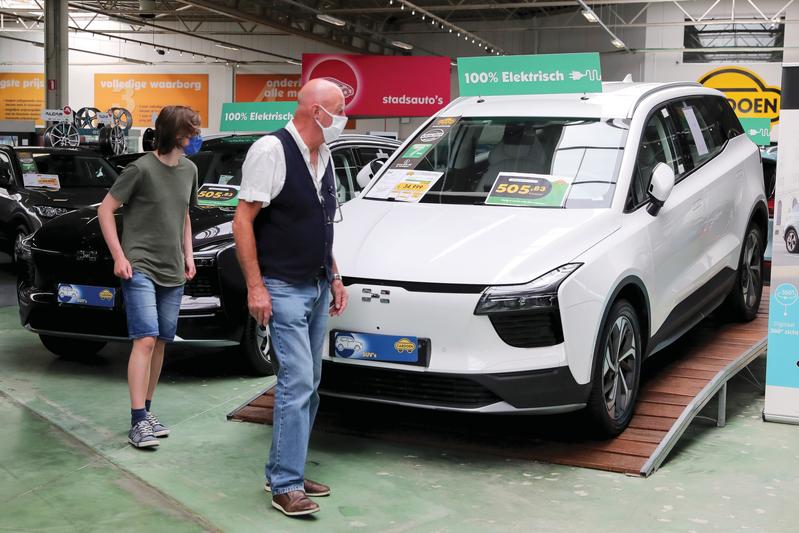 (SONG CHEN / CHINA DAILY)
(SONG CHEN / CHINA DAILY)
For some time, China has been one of the world’s largest vehicle importers — mainly from Europe, where modern automobiles were invented.
The fast rise of new energy vehicles, or NEVs, in the nation, however, offers an opportunity for Chinese carmakers to sell vehicles to Europe and other overseas markets.
Over 310,000 electric cars and plug-in hybrids in total were exported from China last year, according to the China Association of Automobile Manufacturers, or CAAM, more than triple the figure for 2020 — helping the nation’s auto exports reach 2 million.
Statistics from the General Administration of Customs show that of the 10 top destinations, which combined accounted for more than 78 percent of last year’s NEV shipments, five were in Europe: Belgium, the United Kingdom, Germany, France and Slovenia.
Xu Haidong, a deputy chief engineer at CAAM, expects China’s NEV exports to rise further this year.
He said more countries are pushing to achieve carbon-reduction goals, and NEVs are gradually being accepted for daily commuting. However, leading global carmakers have been slower than those in China to go electric.
Toyota, the world’s largest vehicle maker, only came up with its campaign to go electric in December, proposing to launch its first such vehicles this year.
The company’s CEO Akio Toyoda said it is still pursuing a multi-pronged carbon-reduction strategy that also includes hybrid cars and hydrogen-powered vehicles.
Volkswagen, the second-biggest carmaker globally and the largest in Europe, was among the first to move toward electric vehicles, announcing a strategy soon after it was involved in a scandal in the United States in 2015 involving emissions from diesel vehicles.
Yet its ID.3 crossover, the first model on its dedicated electric car platform, did not launch in Europe until late 2020, and even later in other major markets, including China.
In contrast, most major carmakers in China started to offer electric vehicles, or EVs, several years earlier, partly thanks to incentives that started to be offered in 2009, a practice European countries adopted in 2020 and which the US Congress passed late last year.
Great Wall Motors’ Ora electric brand was unveiled in 2018, while Aion — GAC’s EV unit — was established the previous year. BYD, backed by legendary investor Warren Buffett, was already the world’s largest NEV maker in 2016.
Chinese carmakers had a first-mover advantage when countries started to go green.
Take Norway for example. Last year, 65 percent of the country’s new car sales were electric, and the proportion is expected to reach 80 percent this year, according to the Norwegian Electric Vehicle Association.
SAIC Motor, China’s largest carmaker by sales, launched its MG ZS electric SUV in Norway in September 2019. Nine months later, a shipment of 328 electric vans from SAIC’s subsidiary Maxus left China for Norway.
Last year, SAIC delivered more than 50,000 NEVs to Europe, accounting for over 70 percent of its sales to the continent. This year, the company is planning to launch an EV designed for Europe, the first of its kind in the carmaker’s portfolio.
Liu Xinyu, vice-president of SAIC France, said the model is the result of efforts by SAIC’s teams in China and the UK to take full account of European customers’ demands.
He said Europe is seeing a year-on-year rise of about 20 percent in NEV sales.
“Major German carmakers are planning to launch these vehicles as well, but theirs will not be available until 2025, while ours will reach the market this year,” he said.
Yu De, managing director of SAIC’s international business department, said SAIC is strengthening its sales and service network in Europe, where the number of the company’s outlets is due to reach 1,200 this year. “We are opening a new dealership every three days or so,” Yu said.
SAIC aims to sell at least 240,000 NEVs annually in Europe by 2025 as part of its goal to deliver 1.5 million vehicles to overseas markets that year.
 Potential buyers view Chinese-made electric cars at a vehicle market in Antwerp, Belgium. (ZHENG HUANSONG / XINHUA)
Potential buyers view Chinese-made electric cars at a vehicle market in Antwerp, Belgium. (ZHENG HUANSONG / XINHUA)
In August, BYD launched its Tang electric SUV in Norway with local distributor RSA. The 1,000th such vehicle was sold in the Norwegian market in December.
Frank Dunvold, CEO of RSA, said: “We have seen fantastic demand for BYD’s Tang in just a few months since its launch, and this pace will escalate this year.
“The people of Norway are very environmentally conscious, and the pure-electric, zero-emissions Tang SUV is the perfect fit.”
Thanks to its rising acceptance of EVs, Norway is also a popular gateway for Chinese startups in Europe.
Nio, which is based in Shanghai, opened its first overseas showroom in the center of Oslo, the Norwegian capital, last year, aiming to sell its ES8 sport utility vehicles and ET7 sedans as part of plans to expand globally.
This year, the carmaker, which is listed in New York, plans to sell vehicles in Germany, the Netherlands, Sweden and Denmark. According to the company, by 2025 it will have established a presence in more than 25 countries and regions worldwide.
Xpeng, which entered Norway in late 2020, said last month that its vehicles will be available in Sweden and the Netherlands.
Unlike Nio and Xpeng, Aiways started its European journey in Germany in 2020. The startup, which is based in Shanghai, now also sells vehicles in Italy, France, Denmark and Belgium, and plans to enter Switzerland, Spain and Portugal this year.
Compared with established carmakers, startups are not limited by “heritage or expectation”, the company said.
“When Aiways became the first Chinese startup to launch an electric vehicle in Europe, some industry experts were skeptical. But this has proven to be a great advantage for the young EV brand.”
Aiways said its U5 SUV will be joined by a larger U6 coupe SUV this year. The company aims to achieve “five-digit sales” in Europe this year by expanding its lineup and adding new markets.
For conventional Chinese carmakers such as Great Wall Motors, selling vehicles in Germany, where the automobile was invented and perfected, is proof of outstanding quality.
Cui Dongshu, secretary-general of the China Passenger Car Association, said only when Chinese auto companies enter markets in developed countries can they truly take part in international competition.
Great Wall Motors said at the Munich Auto Show in September: “Chinese carmakers now have the courage and ability to take on European brands head-on.”
The company, China’s largest SUV and pickup maker, has set up a European headquarters in Munich, which will serve as a base to reach more markets on the continent. Its premium brand Wey is launching its flagship European model, a plug-in hybrid SUV, this year. Great Wall Motors is also scheduled to open its first European experience center in Munich this year.
The company’s electric marque Ora has also announced a European campaign, with the first model to be delivered this year. Ora will offer five models over two years for European customers, and more than 10 of its models will be available on the continent in 10 years.
Tu Le, founder of consultancy Sino Auto Insights, said: “There is still some heavy lifting to be done to gain the trust of European and US consumers.
“Carmakers need to take their time — the BYD brand is still unfamiliar to the average customer in the US, continental Europe and the UK. The company needs to invest that time, capital and education, and also create awareness and build trust.”
William Li, Nio’s founder and CEO, said it would be a long road to success in a mature market such as Europe, adding that Chinese carmakers may need up to a decade to gain a firm foothold in the continent.
In addition to the large number of Chinese models, Li said better product features, such as improved connectivity and in-cabin infotainment functions, will be key to Chinese carmakers winning buyers.
Yale Zhang, managing director of consulting company Automotive Foresight, said international models have been dwarfed by those from China that boast futuristic features such as big screens, facial recognition and powerful computers.
“Electric cars designed and built using the idea for gasoline cars — meaning that they are good in every aspect but excellent in none — will not sell these days,” Zhang said.
Arnie Richters, chairman of the industry group Platform for Electromobility, which is based in Brussels, said selling cars to Europeans is a “tough business, especially if your product isn’t well known”.
However, providing a wide range of innovative features opens the door to opportunity, Richters added.
Chinese carmakers’ ambitions for electric vehicles are not limited to Europe.
Great Wall Motors said it will offer 10 models in Brazil by 2025, all of them electric. The company made the announcement when it took over a Daimler plant in the South American country in January.
Wuling, an SAIC Motor marque, will sell its popular electric minicars in Indonesia from this year — the first overseas market for models built on the company’s mini-EV platform.
The brand rose to prominence in the EV sector in 2020 with its two-seater Hongguang Mini EV, which once dethroned Tesla’s Model 3 as the world’s best-selling EV.
A representative for the company said more than 200 dealers from 70 countries and regions have expressed interest in the Hongguang Mini EV.


